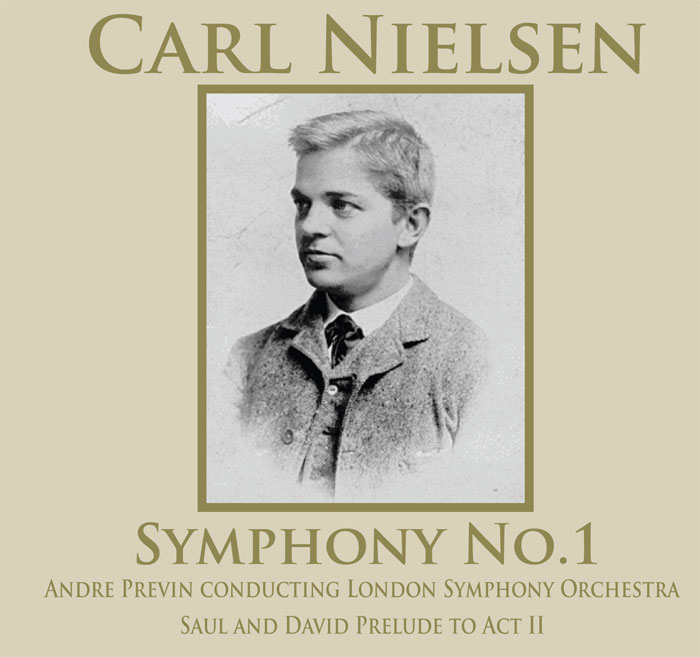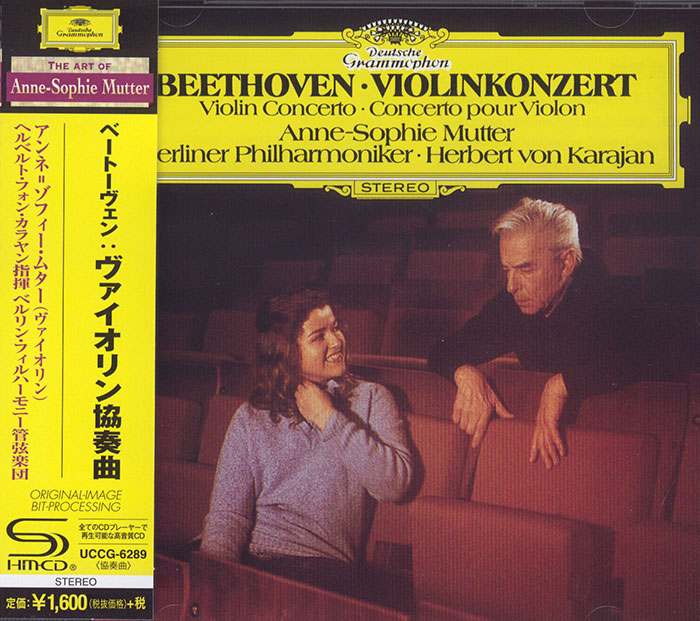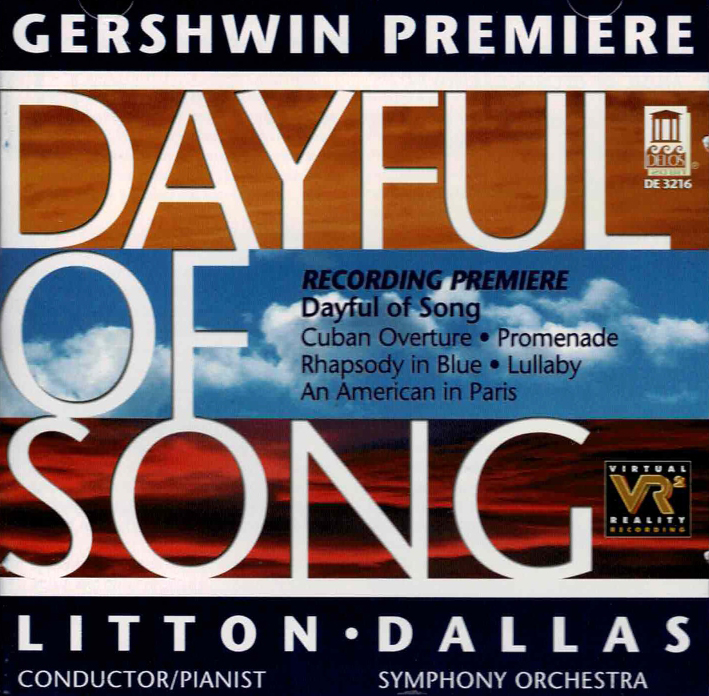Logowanie
Mikołaj - ten to ma gest!
Elton John, The Mamas & The Papas, Cat Stevens, Rod Stewart, Bobbie Gentry, Stevie Wonder, Engelbert Humperdinck
Memory Lane
Edycja Numerowana - 1000 egzemplarzy w skali światowej
RACHMANINOV, Eiji Oue, Minnesota Orchestra
Symphonic Dances / Vocalise
Best Recordings of 2001!!! NAJCZĘŚCIEJ KUPOWANA PŁYTA Z RR!
Karnawał czas zacząć!
Music of Love - Hi-Fi Latin Rhythms
Samba : Music of Celebration
AUDIOPHILE 24BIT RECORDING AND MASTERING
CHOPIN, LISZT, DEBUSSY, DVORAK, Gerhard Oppitz
Dances romantiques - A fantastic Notturno
Wzorcowa jakość audiofilska z Clearaudio
Winylowy niezbędnik
ClearAudio
Double Matrix Professional - Sonic
najbardziej inteligentna i skuteczna pralka do płyt winylowych wszelkiego typu - całkowicie automatyczna
NIELSEN, Andre Previn, The London Symphony Orchestra
Early Recordings
- Andre Previn - conductor
- The London Symphony Orchestra - orchestra
- NIELSEN
Nielsen was the seventh of twelve children in a poor peasant family in Sortelung (Nørre Lyndelse), south of the city of Odense, Denmark. His father was a house painter and amateur musician. Carl first discovered music by experimenting with the sounds and pitches he heard when striking logs in a pile of firewood behind his home.
Nielsen also considered the wistful songs his mother sang and the wedding parties and other festivities at which his father played violin and coronet as other formative musical experiences. Other inspirational sources for his music would become, as David Fanning writes in the New Grove, "the underlying animating forces of nature and human character. They were to become sources of inspiration for his own music, as archetypal embodiments of oneness and conflict respectively".
Nielsen learned the violin and piano as a child and wrote his earliest compositions at the age of eight or nine: a lullaby, now lost, and a polka which the composer notated in his autobiography. He also learned how to play brass instruments, which led to a job as a bugler and alto trombonist in the 16th Battalion at nearby Odense.
He studied at the Royal Danish Academy of Music in Copenhagen from the beginning of 1884 until December 1886. Though not an outstanding student there and composing little, he progressed well in violin under Valdemar Tofte and received a solid grounding in music theory from Orla Rosenho, who would remain a valued adviser during Nielsen's early years as a professional composer. Contacts with fellow students and cultured families in Copenhagen, some of which would become lifelong friends, would become equally important.
The patchy education resulting from his country background left Nielsen insatiably curious about the arts, philosophy and aesthetics; it also left him, Faning writes, "with a highly personal, common man's point of view on those subjects". [1]
Nielsen progressed well enough on the violin to gain a position with the orchestra of the Royal Theater in Copenhagen in September 1889, three years after his graduation from the conservatory. This position would sometimes cause Nielsen considerable frustration but he continued to play there until 1905. In between graduation and attaining this position, he gave violin lessons, made a modest income as a teacher and enjoyed continued support from patrons. Some of Nielsen's string chamber works were performed at this time; these included a Quartet in F which the composer considered his ocial debut as a professional composer. However, the greatest impression was made by Nielsen's Suite for Strings, which was performed at Tivoli Hall on 8 September 1888. Nielsen would designate this work his Opus 1.
After less than a year at the Royal Theater, Nielsen won a scholarship of 1800 kroner, allowing him the means to travel several months in Europe. During this time he discovered and abandoned Richard Wagner's music dramas, heard many of the leading orchestras and soloists in Europe and sharpened his opinions on both music and the visual arts. While revering the music of Bach and Mozart, he remained ambivalent about much 19th century music. In Paris he met the Danish sculptress Anna Marie Brodersen, who was also traveling on scholarship. They toured Italy together, marrying in Florence on 10 March 1891 before returning to Denmark.
"As well as being a love match," Fanning writes, "it was also a meeting of minds. Anne Marie was a gifted artist.... She was also a strong-willed and modern-minded woman, determined to forge her own career." [2] This determination would strain the Nielsens' marriage, as Anne Marie would go for months on location during the 1890s and 1900s, leaving Carl to raise their three young children while fitting in his duties at the Royal Theater and time to compose. While Carl suggested divorce in March 1905, the Nielsens remained married for the remainder of the composer's life. Carl sublimated his anger and frustration over his marriage in a number of musical works, most notably between 1897 and 1904, a period to which he sometimes referred as his "psychological" period. [2] Fanning writes, "At this time his interest in the driving forces behind human personality crystallized in the opera Saul og David and the Second Symphony ("De re temperamenter") and the cantatas Hymnus amoris and Søvnen.
At first, he did not gain enough recognition for his works to support him. During the concert which saw the premiere of his first symphony on 14 March 1894 conducted by Johan Svendsen, Nielsen played in the second violin section. However, the same symphony was a great success when played in Berlin in 1896, and from then his fame grew. Nielsen became increasingly in demand to write incidental music for the theater and for cantatas to mark special occasions; these provided a welcome source of additional income. "A reciprocal relationship grew up between his programmatic and symphonic works," Fanning writes; "sometimes he would find stageworthy ideas in his supposedly pure orchestral music; sometimes a text or scenario forced him to invent vivid musical imagery which he could later turn to more abstract use."
Beginning in 1901, Nielsen received a modest state pension—800 kronen at first, growing to 7500 kronen by 1927—to augment his violinist's salary. This allowed him to stop taking private pupils and left more time to compose. From 1903 he also had an annual retainer from his principal publisher, Wilhelm Hansen Edition. Between 1905 and 1914 he served as second conductor at the Royal Theatre. From 1914-26, he conducted the orchestra of "Musikforeningen". In 1916 he took a post teaching at the Royal Danish Academy of Music in Copenhagen, and continued to work there until his death, in his last year as director of the institute.
Personally, the strain of dual careers and constant separation from his wife led to more than one extra-marital aair. When the last one came to light, between Nielsen and the governess of his children, the result was an eight-year breach in his marriage. During much of this time Carl and Anne Marie lived apart and the period led to a creative crisis for Nielsen, bringing about a powerful reappraisal of himself as a composer. This, along with World War I and professional developments in his life, would strongly inuence his Fourth and Fifth Symphonies, arguably his greatest works.
For his son-in-law, the Hungarian violinist Dr. Emil Telmányi, Nielsen wrote his Violin Concerto, Op. 33 (1911).
Nielsen suered a serious heart attack in 1925 and from that time on he was forced to curtail much of his activity, although he continued to compose until his death. Also during this period he wrote a delightful memoir of his childhood called My Childhood on Funen (1927). He also produced a short book of essays entitled Living Music
Nagranie dostępne w formatach i na nośnikach:
Płyta CD, bezpośrednia kopia z kompuetra masteringowego, na Gold CD-R
HQCD (High Quality Compact Disc) Płyta do odtworzenia w każdym typie czytników CD i DVD
Studyjny plik FLAC o rozdzielczości 24bit 192khz
Elementy toru masteringowego
• Digital: Digital Audio Denmark AX24 Analog to Digital Converter
• Lynx AES16 used for digital I/O Antelope Audio Isochrone OCX Master Clock
• Weiss Saracon Sample Rate Conversion Software Weiss POW-r Dithering Software
• Analog: Studer 810 Reel to Reel with JRF Magnetics Custom Z Heads & Siltech wiring
• Aria tape head pre-amp by ATR Services
• Manley Tube Tape Pre-amps Modified by Fred Volz of Emotive Audio
• Cables: Purist Audio Design, Pure Note, Siltech
• Power Cords: Purist Audio Design, Essential Sound Products
• Vibration Control: Symposium Acoustics Rollerblocks,Ultra platforms, Svelte shelves
• Sonic Studio CD.1 Professional CD Burner using Mitsui Gold Archival CD's
***********************

Robert Witrak - meloman, audiofil, inżynier jest jednym z nielicznych na świecie kolekcjonerów analogowych taśm z nagraniami wykonanymi w technologii zapisu na dwóch i czterech ścieżkach. Słowem – zbiera taśmy magnetofonowe z profesjonalnie zarejestrowanymi koncertami wielkich orkiestr, słynnych solistów i sławnych dyrygentów. Zbiera materiały źródłowe, najlepsze pod względem jakości i wierności brzmienia, nie przetworzonych, bez ingerencji bezdusznej elektroniki. I, co najważniejsze – utrwalonych w złotych latach współczesnej fonografii. To nagrania o jakości Living Stereo, Mercury Living Presence czy Everest!
Wiele z tych rejestracji uzyskało już status „public domain” – wygasły do nich majątkowe prawa autorskie, nie ma więc ograniczeń formalno-prawnych by pozostawały one w sejfach i magazynach kolekcjonerów. Te cymelia, unikatowe rejestracje, koncerty o wartości historycznej nie mniejszej niż ich walory artystyczne, mogą więc wejść do obiegu kulturowego całego świata. Dzięki firmie HDTT. High Definition Tape Transfers.
Proces reprodukcji tych archiwalnych nagrań zaczyna się od starannego przygotowania taśmy-matki. Musi ona być nie tylko przechowywana w szalenie rygorystycznie warunkach (odpowiednia temperatura, wilgotność, brak obciążeń mechanicznych, nieustanne przekładanie), ale także poddawana specjalistycznej konserwacji. W nieskazitelnym stanie technicznym, zarówno pod względem mechanicznym jak i elektronicznym, musi być utrzymywany cały tor dźwiękowy. Szczególnie ważna jest perfekcyjna praca magnetofonu i stan głowicy. To warunki rzeczywiście wiernego przeniesienia jakości nagrania analogowego na nośnik cyfrowy.
Efekt? Efekt tej benedyktyńskiej pracy, wykonanej z wielkiej miłością do doskonałej jakości muzyki, jest wprost oszałamiający.
NIE ZNAJDĄ PAŃSTWO DZIŚ NA RYNKU NAGRAŃ O JAKOŚCI - W ZAKRESIE DYNAMIKI I PRAWDY BRZMIENIA, A TAKŻE WARTOŚCI ARTYSTYCZNEJ - PORÓWNYWALNEJ ZE STANDARDEM WYZNACZONYM PRZEZ HDTT!
Jakość brzmienia da się porównać tylko do muzyki granej na żywo!
NOŚNIKI.
Aby było możliwe tak wierne odwzorowanie na nośniku cyfrowym jakości analogowego brzmienia, opracowano nowy nośnik i technologię jego przygotowania:
High Quality CD
Jest to nowy standard w dziedzinie zachowania jakości oraz wierności muzyki nagranej w technologii analogowej i przeniesionej na płytę kompaktową, do odtworzenia w każdym typie czytnika na świecie. Autorem tej technologii jest Taiyo Yuden. Wykorzystał on materiały o szczególnej przejrzystości i jednorodności, odpowiednio zabarwione, bezbłędnie wręcz przyjmujące nanoszone na nie informacje. Nagrywanie tych płyt jest procesem długotrwałym, odbywa się w czasie rzeczywistym. Moglibyśmy wręcz użyć określenia – direct-to-disc. Proces nagrywania odbywa się w urządzeniu, które generuje najniższy z notowanych dziś współczynnik błędów (jitter). Innymi słowy – uzyskujemy zapis o najwyższych parametrach. Jako źródło dźwięku wykorzystywany jest studyjny zmodyfikowany magnetofon stacyjny. Dźwięk przetwarzany jest następnie przez renomowane przetworniki Weiss digital A/D. W procesie masteringu używane są audiofilskiej klasy interkonekty oraz komponenty firmy Symposium, tłumiące wibracje i zakłócenia (pinch-rolki, osie, prowadnice).
Technologia HQCD pozwala wytworzyć najlepsze płyty CD na świecie. Dźwięk z nich płynący charakteryzuje się niesłychaną głębią i przejrzystością oraz lepiej rozłożoną sceną muzyczną.
Płyty HQCD nagrane przez HDTT – to zupełnie nowy, nieznany wcześniej wymiar i kosmos dźwięku!
DVD-Audio
Materiały z HDTT dostępne są także w postaci płyt DVD-Audio, do odtworzenia wyłącznie w czytnikach DVD i Blu-ray. Format 24/196 zapewnia nieporównywalną z klasycznymi czytnikami CD jakość odtwarzanej muzyki. Ta kwestia nie podlega żadnej dyskusji.
Pliki FLAC
Jednak najbardziej wyrafinowana postacią materiałów z HDTT są pliki flak o jakości 24bit/96kHz oraz 24bit/192kHz.
FLAC – to format bezstratnej kompresji dźwięku. W przeciwieństwie do innych kodeków dźwięku takich jak Vorbis, MP3 i AAC (każdy z nich powoduje niewielkie ale jednak wyraźnie odczuwane ingerowanie w strukturę danych, powoduje słyszalną kompresję), kodek FLAC nie usuwa żadnych danych ze strumienia audio. Otrzymujemy więc w wyniku dekompresji dźwięk tożsamy z pierwowzorem. Format FLAC jest dziś wykorzystywany przez większość oprogramowania do edycji i odtwarzania dźwięku. Powtórzmy – muzyka z plików FLAC nie ma żadnej konkurencji ze strony innych formatów czy nośników. Jest reprodukowana na wyższym poziomie niż z płyt HQCD.
To byłoby na tyle – chciałoby się przywołać pełne bezpretensjonalności zawołanie poety. Dzięki HDTT, HQCD oraz DVD-Audio a nade wszystko plików FLAC wchodzą Państwa w najbardziej intymny, niczym nie ograniczony związek z Jej Wysokością Muzyką.
Wielu wrażeń!
(1925). Both have been translated into English. He died in Copenhagen in 1931.































